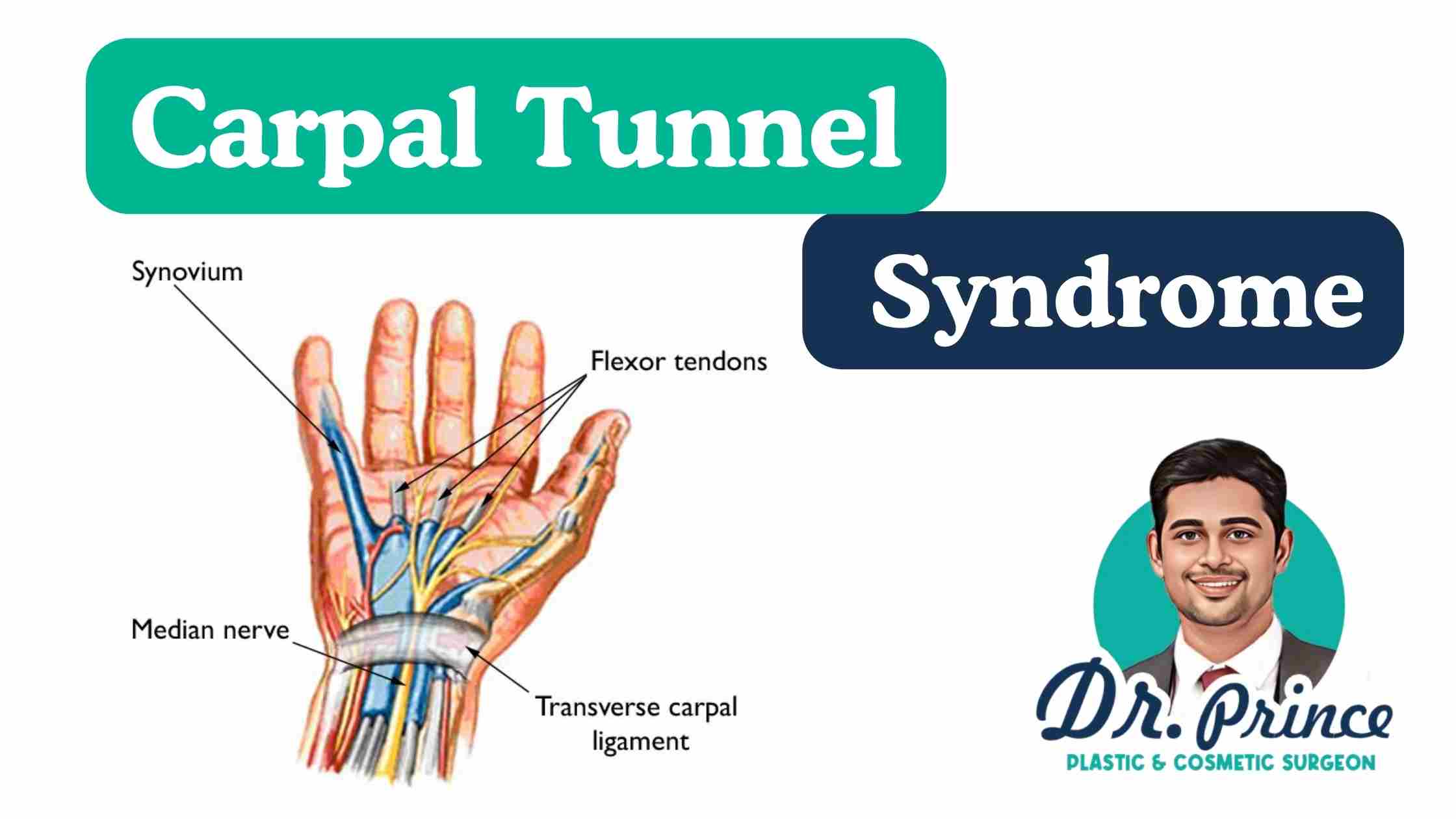Carpal Tunnel Syndrome (CTS) is a prevalent condition causing discomfort and potential long-term damage to the hand and forearm. This comprehensive guide explores the nuances of CTS, its symptoms, and the importance of timely intervention, specifically within the vibrant healthcare landscape of Kerala.
👐 The Essence of Carpal Tunnel Syndrome: Carpal Tunnel Syndrome manifests when the median nerve, a crucial neural pathway to the hand, is compressed within the wrist. This compression leads to sensations of numbness, tingling, and pain.
🚨 The Urgency of Early Intervention: CTS tends to worsen over time, underscoring the critical need for early diagnosis and treatment. Left untreated, it may result in irreversible hand dysfunction, including sensory loss and weakness.
🌟 Simple Measures for Early Relief: Discover practical measures to alleviate early symptoms of CTS, such as wearing a wrist splint, nerve-mobilizing exercises, and avoiding activities that exacerbate discomfort. Learn how these simple interventions can provide relief in the initial stages.
💉 Exploring Medical Interventions: Delve into medical interventions for CTS, including the administration of steroid injections into the carpal tunnel. Uncover how these approaches aim to mitigate pressure on the median nerve and alleviate symptoms.
🔍 Surgical Solutions for Lasting Relief: In cases where pressure on the median nerve persists, surgical intervention becomes paramount. Explore the surgical options available to relieve pressure and prevent permanent nerve damage.
🤝 Navigating Carpal Tunnel Syndrome in Kerala: Understand the unique healthcare landscape of Kerala and how individuals grappling with CTS can access expert care and interventions. Explore the intersection of traditional wellness practices and modern medical solutions.
🔗 Connecting with Dr. Prince: For specialized care and insights on Carpal Tunnel Syndrome in Kerala, connect with Dr. Prince, a renowned plastic surgeon with expertise in hand-related issues.
Anatomy
Embark on a journey through the intricate anatomy of the carpal tunnel, a crucial pathway in the wrist that plays a pivotal role in hand function. In this exploration, we unravel the details of this narrow passageway and its integral components, shedding light on the significance of its rigid boundaries and the vital structures it houses.
🌐 The Carpal Tunnel Blueprint: Dive into the architectural blueprint of the carpal tunnel, spanning just an inch in width. Explore how the small carpal bones form the floor and sides, while the robust transverse carpal ligament acts as the unyielding roof, creating a confined space with minimal stretching capacity.
🤝 The Median Nerve’s Journey: Follow the path of the median nerve, a key player in hand sensation and muscle control. Originating from nerve roots in the neck, it navigates through the upper arm, elbow, and forearm, ultimately passing through the carpal tunnel. Delve into its role in providing feeling to specific fingers and controlling essential thumb muscles.
🧠 Nerve Roots to Hand Harmony: Understand the intricate connection between nerve roots in the neck, the journey of the median nerve, and the distribution of sensation in the thumb, index finger, middle finger, and part of the ring finger. Appreciate how this neurological symphony contributes to the delicate balance of hand function.
🖐️ Beyond Sensation: Tendons and Functionality: Explore the coexistence of nine flexor tendons within the carpal tunnel, crucial for the flexing motion of fingers and thumb. Uncover the seamless interplay between these tendons and the median nerve, highlighting the integrated functionality that enables everyday hand activities.
🤲 Dr. Prince’s Expertise: Gain valuable insights into carpal tunnel anatomy from the perspective of Dr. Prince, a distinguished plastic surgeon. Discover how his expertise enhances the understanding of this complex anatomical structure, offering a unique blend of medical knowledge and practical application.
Description
Understanding Carpal Tunnel Syndrome (CTS) involves unraveling the intricate mechanisms that lead to its manifestation. At the heart of this condition is the narrowing of the carpal tunnel or swelling of the synovium, the tissue surrounding the flexor tendons. Driven by these factors, pressure builds on the crucial median nerve, affecting both its function and blood supply.
🌐 The Carpal Tunnel Constriction: Gain a profound understanding of how the carpal tunnel undergoes narrowing, a pivotal factor in CTS. Explore the anatomical complexities that contribute to this constriction and comprehend the consequences it poses to the median nerve.
🔄 Synovial Swelling: Dive into the role of synovium, the protective tissue surrounding the flexor tendons, in the onset of CTS. Examine how swelling of this synovial layer can escalate, exerting pressure on the median nerve and initiating a cascade of symptoms.
🤔 Impact on the Median Nerve: Delve into the repercussions of abnormal pressure on the median nerve, uncovering the diverse array of symptoms it can induce. From numbness and tingling to pain and weakness, grasp the nuanced ways in which CTS affects hand functionality.
🩸 Reduced Blood Supply: Understand the implications of reduced blood supply to the median nerve within the constrained carpal tunnel. Explore the physiological intricacies that contribute to compromised blood flow, exacerbating the symptoms and intensifying the impact on hand health.
👨⚕️ Professional Insights by Dr. Prince: Navigate through the insights provided by Dr. Prince, a distinguished plastic surgeon, as he sheds light on the professional perspective of CTS. Benefit from his expertise as he dissects the anatomical and physiological aspects, offering a comprehensive view of this common yet intricate condition.
Cause
Carpal Tunnel Syndrome (CTS) emerges as a multifaceted condition, often influenced by an interplay of various factors. Delving into the intricacies of CTS risk factors provides valuable insights for a comprehensive understanding.
👩🦳 Demographic Dynamics: Explore the statistical nuances indicating a higher prevalence of CTS among women and older individuals. Uncover the correlation between demographic factors and the likelihood of developing this condition, shedding light on the importance of age and gender in its manifestation.
🧬 Heredity’s Hidden Role: Delve into the genetic dimension of CTS, where heredity emerges as a crucial factor. Unravel how familial traits may contribute to a naturally smaller carpal tunnel or anatomical differences, creating a predisposition to this syndrome that transcends generations.
🤲 Repetitive Motion Reckoning: Gain insights into the impact of repetitive hand use, a significant risk factor for CTS. Understand how prolonged, repetitive motions or activities can aggravate wrist tendons, leading to swelling and subsequent pressure on the median nerve.
🔀 Hand and Wrist Dynamics: Explore the influence of hand and wrist positions on CTS development. Uncover how activities involving extreme flexion or extension over an extended period can elevate pressure on the median nerve, contributing to the onset of symptoms.
🤰 Pregnancy’s Pivotal Role: Understand the hormonal dynamics during pregnancy and their role in CTS. Explore how hormonal changes induce swelling, exerting pressure on the nerve and making pregnant individuals more susceptible to this condition.
🩺 Health Conditions Connection: Navigate through the association between certain health conditions and CTS. Examine the correlation with diabetes, rheumatoid arthritis, and thyroid gland imbalance, shedding light on the intricate web of factors contributing to this syndrome.
👨⚕️ Professional Insights by Dr. Prince: Benefit from the expertise of Dr. Prince as he provides professional perspectives on the intricate risk factors associated with CTS. Gain a nuanced understanding of the amalgamation of elements that can contribute to the development of this prevalent condition.
Symptoms
Carpal Tunnel Syndrome (CTS) manifests through a spectrum of symptoms, creating a distinctive language that communicates the challenges faced by affected individuals. Unraveling these symptoms is crucial for timely diagnosis and intervention.
🤔 Deciphering the Signs: Embark on a journey into the nuanced symptoms of CTS, where numbness, tingling, burning, and pain take center stage. Explore the geographical distribution of these sensations, predominantly affecting the thumb and specific fingers, often disrupting sleep with nighttime awakenings.
⚡ Electric Current Sensations: Navigate the occasional shock-like sensations that radiate through specific fingers, adding an electric current dimension to the symptomatology. Understand how these sensations contribute to the overall tapestry of discomfort experienced by individuals with CTS.
🔍 Traveling Pain and Tingling: Explore the trajectory of pain and tingling, tracing its path from the wrist to the forearm and even reaching the shoulder. Gain insights into the diverse ways in which discomfort can manifest along the upper extremity, providing valuable diagnostic cues.
💪 Muscular Weakness and Clumsiness: Delve into the impact of CTS on hand functionality, unveiling the presence of weakness and clumsiness. Understand how these symptoms can pose challenges to fine motor movements, potentially affecting daily activities such as buttoning clothes.
🤲 Proprioceptive Predicaments: Grasp the concept of proprioception and its role in CTS symptoms. Uncover how a loss of awareness regarding hand positioning in space can contribute to the difficulty experienced by individuals in holding objects, resulting in unintentional dropping.
🔄 Gradual Onset and Progressive Nature: Examine the temporal aspects of CTS symptoms, characterized by a gradual onset without a specific injury. Understand the fluctuating nature of symptoms initially and their evolution into more persistent and frequent occurrences as the condition advances.
🌙 Nocturnal Disruptions: Uncover the prevalence of nighttime symptoms in CTS, driven by the common practice of sleeping with wrists bent. Explore how these nocturnal disruptions can significantly impact the quality of sleep and contribute to the overall burden of the condition.
✋ Movement as a Palliative Measure: Discover the coping mechanisms adopted by individuals with CTS, such as moving or shaking their hands to alleviate symptoms. Gain insights into these self-initiated strategies for symptom relief.
👨⚕️ Expert Commentary by Dr. Prince: Benefit from the professional commentary of Dr. Prince as he provides insights into the intricate language of CTS symptoms. Leverage his expertise to deepen your understanding of the diverse ways in which CTS manifests.
Physical Examination
Embarking on the journey to diagnose Carpal Tunnel Syndrome (CTS) involves a comprehensive evaluation, where your doctor becomes a detective, unraveling the clues presented by your symptoms and medical history.
🤝 Establishing a Health Narrative: Begin with a conversation, where your doctor delves into your general health and medical history. Through this exchange, they aim to construct a comprehensive narrative, understanding the context of your symptoms and their impact on your daily life.
🔍 Physical Examination Precision: Enter the realm of a meticulous physical examination focused on your hand and wrist. Your doctor employs a series of precise tests, including the renowned Tinel’s sign, involving pressure and tapping along the median nerve to unveil any tingling sensations in your fingers.
🔄 Flexing and Probing: Witness the flexing and holding of your wrists in various positions to assess for numbness or tingling—a dynamic exploration aimed at capturing the nuances of your symptoms. This hands-on approach provides valuable insights into the manifestations of CTS.
👁️ Sensory Exploration with Precision: Experience the sensitivity testing of your fingertips and hands, where a specialized instrument delicately touches your skin. This sensory exploration, conducted with closed eyes, allows your doctor to gauge the intricacies of your tactile perception.
💪 Assessing Muscular Strength: Participate in the assessment of muscular strength around the base of your thumb. Your doctor evaluates potential weakness, recognizing the role these muscles play in hand functionality. This examination unveils the impact of CTS on the motor aspects of your hand.
🔍 Detecting Atrophy: In severe cases, the quest for diagnostic clarity extends to the detection of atrophy in the muscles around the base of your thumb. Your doctor keenly observes for any visible signs of muscle wasting, adding a visual dimension to the diagnostic process.
👨⚕️ Guided by Expert Hands: Your diagnostic journey is guided by the expert hands of your doctor, who skillfully navigates the intricate landscape of CTS assessment. Benefit from their expertise as they interpret findings and tailor the diagnostic approach to your unique presentation.
⚖️ Balancing Precision and Compassion: Witness the delicate balance between precision and compassion in the diagnostic process. Your doctor combines technical expertise with empathetic understanding, creating a patient-centric evaluation that seeks both answers and reassurance.
Tests
🌐 Decoding Nerve Signals: The Intricacies of Electrophysiological Testing
Embark on a journey into the realm of electrophysiological testing—a sophisticated diagnostic tool designed to unravel the intricacies of nerve function. When grappling with the mysteries of Carpal Tunnel Syndrome (CTS), your doctor may guide you through this enlightening process, offering valuable insights into the health of your median nerve.
📊 Measuring the Symphony of Nerve Activity: Picture a symphony where nerve signals play the role of harmonious notes. Electrophysiological testing serves as the conductor, meticulously measuring how well your median nerve contributes to this symphony. Through this process, your doctor gains a quantitative understanding of the nerve’s functionality.
🛠️ Assessing Pressure Dynamics: The essence of these tests lies in their ability to gauge pressure dynamics. Are there signs of excessive pressure on the median nerve? Is there compression occurring at various locations? Electrophysiological testing skillfully addresses these questions, providing a comprehensive view of the pressure landscape.
📈 Quantifying Severity Levels: Beyond a mere binary diagnosis, these tests offer a nuanced understanding of CTS severity. Your doctor can quantify the impact, distinguishing between mild, moderate, and severe presentations. This precision enables tailored interventions that align with the unique nature of your condition.
🌐 Unveiling Compression Patterns: The journey doesn’t end with the median nerve alone. Electrophysiological testing sheds light on the broader landscape—are other nerves entangled in the narrative? By uncovering compression patterns, your doctor gains insights into the multifaceted nature of nerve involvement.
🔍 Detecting Underlying Conditions: Life’s complexities extend beyond CTS. These tests act as detectives, searching for clues of additional medical conditions, such as neuropathy, that may coexist with CTS. This holistic approach ensures a comprehensive understanding of your nerve health.
👩⚕️ Your Partner in Diagnostic Clarity: As you navigate the realm of electrophysiological testing, envision your doctor as a trusted guide. Their expertise transforms complex data into actionable insights, paving the way for informed decisions about your health. This collaborative journey aims for diagnostic clarity and personalized care.
⚖️ Balancing Precision and Compassion: In the quest for diagnostic precision, your doctor seamlessly integrates compassion. The intricacies of electrophysiological testing are presented with clarity, empowering you to comprehend the symphony of nerve signals and actively participate in your healthcare journey.
📊 Navigating the Diagnostic Landscape: Unraveling Carpal Tunnel Syndrome with Advanced Imaging
Embark on a diagnostic odyssey as we delve into the sophisticated realm of electrophysiological tests, each a unique lens offering insights into the intricacies of your nerve health.
🚦 Nerve Conduction Studies (NCS): Mapping the Signal Pathways Imagine these tests as cartographers, meticulously mapping the signal highways within your hand and arm. Nerve conduction studies (NCS) serve as the compass, detecting deviations and inefficiencies in the nerve’s signal conduction. By quantifying the severity of the issue, NCS becomes a valuable guide, steering your doctor toward tailored treatment strategies.
⚙️ Electromyogram (EMG): Decoding Muscular Dialogues Within the orchestra of your hand, an electromyogram (EMG) acts as the virtuoso, decoding the electrical dialogues within muscles. Resulting insights unveil the presence of nerve or muscle damage, providing a symphony of information that informs your doctor’s diagnostic score.
🔍 Ultrasound: Illuminating the Nerve’s Landscape Picture ultrasound as the illuminator, using high-frequency sound waves to paint vivid pictures of bone and tissue. A wrist ultrasound becomes a canvas, scrutinized for signs of compression on the median nerve. This visual exploration enhances diagnostic precision, offering a non-invasive glimpse into the intricate topography of your wrist.
📷 X-rays: Capturing Bone Chronicles X-rays step into the spotlight, capturing the skeletal chronicles of your wrist. When limited motion or pain takes center stage, X-rays become storytellers, excluding alternate narratives such as arthritis, ligament injuries, or fractures. These images, rich in detail, complement the diagnostic symphony, ensuring a comprehensive exploration.
🧲 Magnetic Resonance Imaging (MRI): Peering into Soft Tissue Realms In the quest for nuanced revelations, MRI emerges as the navigator, providing unparalleled insights into soft tissues. Your doctor orchestrates this advanced imaging technique to unveil hidden narratives—identifying causes beyond CTS, scrutinizing abnormal tissues, and investigating nerve-related anomalies like tumors or scarring from injuries. MRI elevates diagnostic scrutiny, revealing dimensions beyond the visible.
🤝 Collaborative Diagnostic Mastery: As each test contributes its unique melody to the diagnostic symphony, envision your doctor as the conductor, harmonizing the diverse insights into a comprehensive diagnostic masterpiece. This collaborative journey ensures that your unique health narrative is heard and understood.
Treatment
🌱 Carpal Tunnel Syndrome: Nurturing Early Intervention for Lasting Relief
Embark on a proactive journey towards hand health, where early evaluation and diagnosis emerge as the guardians against the gradual progression of carpal tunnel syndrome (CTS). Let’s unravel the significance of timely intervention.
🔄 A Gradual Unfolding: Understanding CTS Progression Much like the subtle turning of seasons, carpal tunnel syndrome unfolds gradually, often evading immediate notice. Yet, beneath the surface, a complex interplay of nerve compression and tissue dynamics is at play. Recognizing the signs early on becomes the compass, steering us away from the potential intensification of symptoms.
🚨 The Imperative of Early Evaluation: Paving the Path to Relief Early intervention isn’t just an option; it’s a cornerstone in the management of CTS. Your doctor, akin to a seasoned navigator, can chart a course of action to potentially slow or halt the disease’s progression. In the early stages, simple measures may suffice—wrist splints, targeted exercises, and lifestyle adjustments may emerge as formidable tools, offering a bulwark against the advancing tide.
🔍 The Diagnostic Sentinel: Your Doctor’s Role Consider your doctor as the sentinel, equipped with the expertise to discern subtle signals that may elude untrained eyes. Through a careful examination, including electrophysiological tests and imaging, they decipher the nuances of your nerve health. This diagnostic vigilance not only confirms the presence of CTS but also unveils the intricacies of its stage, empowering both patient and physician to make informed decisions.
⏳ Mastering the Art of Prevention: Lifestyle and Ergonomics In the early chapters of CTS, the narrative of prevention takes center stage. Lifestyle modifications, ergonomic adaptations, and targeted exercises become the protagonists, shaping a narrative of proactive well-being. Your doctor, acting as a guide, imparts insights into daily practices that may mitigate stress on the median nerve, laying the foundation for lasting relief.
🌈 A Journey of Collaborative Care: Patient-Physician Alliance As we navigate the labyrinth of CTS, envision this journey as a collaboration between patient and physician. Early evaluation isn’t merely a diagnostic milestone; it’s a catalyst for a partnership aimed at enhancing hand health. Together, we embrace the potential to rewrite the script, fostering a narrative of relief, resilience, and renewed well-being.
Nonsurgical Treatment
🛠️ Navigating Carpal Tunnel Syndrome: A Comprehensive Guide to Treatment Options
Unravel the intricacies of carpal tunnel syndrome (CTS), where timely intervention can be the key to relief. Explore the spectrum of treatment options, from nonsurgical approaches to surgical precision.
🌿 Nonsurgical Symphony: Harmony in Holistic Treatment Embrace the prospect of relief without the need for surgery through a nuanced approach to nonsurgical interventions. Your doctor, akin to a conductor orchestrating a symphony, may recommend:
🤲 Bracing or Splinting: Embracing the Night Wearing a brace or splint at night can be akin to providing a serene night’s rest for your median nerve. This subtle measure, by maintaining a neutral wrist position, helps alleviate pressure within the carpal tunnel.
💊 Nonsteroidal Anti-Inflammatory Drugs (NSAIDs): Taming the Inflammatory Cadence Anti-inflammatory medications such as ibuprofen and naproxen emerge as allies in quelling pain and inflammation, harmonizing the melody of discomfort.
🔄 Activity Changes: A Dance of Adaptation The rhythm of symptoms often dances in sync with prolonged hand and wrist positions. Adjustments to your daily activities, be it at work or leisure, may emerge as a choreography of relief.
🏋️ Nerve Gliding Exercises: A Ballet of Mobility For some, exercises that enhance the graceful movement of the median nerve within the carpal tunnel may be prescribed. Your doctor, akin to a choreographer, guides you through these targeted movements.
💉 Steroid Injections: A Crescendo of Relief Cortisone injections, a potent anti-inflammatory, take center stage in alleviating symptoms. Whether as a diagnostic aid or a therapeutic measure, these injections may offer respite.
🔍 Surgical Sonata: Precision in Carpal Tunnel Release When the cadence of nonsurgical measures falls short, the prospect of surgical intervention emerges. The decision is finely tuned, considering factors such as symptom severity, physical exam findings, response to nonoperative treatment, and diagnostic results.
📜 Decision Criteria: Balancing the Scales The choice for surgery is a harmonious blend of medical assessment and patient experience. In long-standing cases or those with constant numbness, surgery may be the crescendo, preventing irreversible damage.
🔪 Surgical Composition: Carpal Tunnel Release The surgical opus unfolds through a procedure known as carpal tunnel release. This meticulous process involves cutting the transverse carpal ligament, the architectural roof of the tunnel. Whether through an open or endoscopic technique, the goal remains constant: to relieve pressure on the median nerve.
🌌 Postoperative Crescendo: Path to Recovery Following surgery, the ligament may gradually regrow, creating a more spacious carpal tunnel. The duet of open and endoscopic surgeries exhibits similar outcomes, with nuances discussed by your surgeon.
Embark on this symphonic journey through CTS, where the cadence of treatment harmonizes with the uniqueness of each patient. Your doctor, as the conductor, ensures a personalized approach, orchestrating relief and restoring the melody of hand health.
Recovery
🌙 Postoperative Serenade: Nurturing Your Hand to Harmony
Embarking on the path to recovery post-surgery, your hand becomes a canvas for the artistry of healing. Let’s navigate the immediate aftermath of the procedure, orchestrating steps for optimal recovery.
🌟 Initial Crescendo: Elevating and Nurturing Directly following surgery, the symphony of healing commences with a call to elevate your hand above heart level. This strategic positioning, akin to a conductor guiding a performance, aims to reduce swelling and foster a harmonious healing environment. Simultaneously, gentle movements of your fingers become the notes that ward off stiffness, introducing flexibility to the melody of recovery.
🎵 Harmonizing with Discomfort: Pain, Swelling, and Stiffness In the aftermath, anticipate a trio of sensations—pain, swelling, and stiffness—each playing its part in the healing composition. A minor soreness, a transient member of this ensemble, may linger in your palm for weeks to months. Fear not; this is the transient discord before the symphony of recovery takes center stage.
🌙 Nocturnal Symphony: A Shift in Nighttime Notes The nocturnal realm experiences a transformative shift. Nighttime symptoms, once the orchestrators of discomfort, take a melodious turn toward improvement in the initial week post-surgery. This positive transition becomes a key movement in the recovery concerto, promising relief that echoes through the night.
As you traverse this postoperative overture, each passing week adds a layer to the composition, with pain giving way to comfort and stiffness yielding to suppleness. Your surgeon, the guiding maestro, ensures that every note aligns with the cadence of your healing journey.
Grip and pinch strength
🌈 Resilience Unfolding: A Symphony of Strength’s Return
Embarking on the journey of postoperative restoration, the recovery of grip and pinch strength emerges as a resilient melody, gradually attaining its crescendo. Let’s explore the tempo of strength revival and the harmonious notes that accompany this process.
🤝 Reclaiming Strength: A Gradual Overture Within the initial 2 to 3 months post-surgery, the cadence of strength begins to reassert itself, marking the commencement of the recovery symphony. As you traverse this timeframe, the returning grip and pinch strength paint a vibrant overture of resilience, each passing week adding a nuanced layer to the composition.
⏳ A Patience-Packed Movement: Timeline for Enhancement For those whose median nerve faced challenges before surgery, the crescendo of strength might unfold at a measured pace. A patient duet, spanning approximately 6 to 12 months, accompanies this unique movement. It’s a testament to the resilience of your hand, gradually reclaiming its strength amid the melody of recovery.
🎵 A Complex Chorus: Severe Cases and Lasting Impact In instances of severe carpal tunnel syndrome, where the pre-surgery strength might have faced substantial challenges, the return to normalcy becomes a complex chorus. While the symphony of strength may not fully replicate its pre-symptomatic state, surgery emerges as a crucial movement. Even in these cases, where echoes of the past linger, the intervention serves as a guardian, preventing further deterioration and preserving the functionality of the nerve.
As the resilience of your hand unfolds, each passing note in the symphony of strength echoes the spirit of recovery. Your hand, once silenced by discomfort, now orchestrates a resilient melody—a testament to the transformative power of surgical intervention.
Complications
Understanding Possible Complications
Embarking on the surgical voyage of carpal tunnel release, it’s crucial to be acquainted with potential navigational challenges. While complications are inherent to any surgical undertaking, the dedicated efforts of your medical team aim to minimize these risks. Let’s explore the common intricacies that may arise during this transformative journey.
💉 Hemodynamic Harmonies: Navigating Bleeding Concerns Within the symphony of surgery, the potential for bleeding represents a nuanced note. Though meticulously orchestrated, there exists a possibility of this hemodynamic melody manifesting as a complication. Vigilant measures by your surgical team aim to harmonize the surgical score, mitigating the risk of bleeding to ensure a smooth surgical crescendo.
🦠 Guardians of Asepsis: Addressing Infection as a Narrative Twist In the surgical narrative, the specter of infection occasionally emerges as an unforeseen twist. The safeguarding of asepsis stands as a crucial protagonist, with your surgical team meticulously choreographing measures to minimize this risk. As the storyline unfolds, stringent infection control measures play a pivotal role in preserving the harmony of postoperative healing.
🩹 Wound Healing Ballet: A Choreography of Precision The dance of wound healing, though typically graceful, may encounter occasional missteps. Wound healing issues, akin to a ballet with intricate movements, are acknowledged as potential complications. Your surgical team, committed to the precision of this choreography, takes measured steps to optimize wound healing and ensure a seamless recovery performance.
⚡ Navigating Nerve Pathways: Minimizing Nerve Aggravation or Injury In the intricate tapestry of nerve pathways, the risk of aggravation or injury adds a layer of complexity to the surgical narrative. Your surgical team, akin to skilled navigators, employs techniques and protocols designed to minimize this potential complication. Through their expertise, they chart a course that prioritizes the preservation of nerve integrity.
As you embark on this surgical odyssey, the awareness of these potential complications equips you with the knowledge to navigate the journey with informed resilience. Your surgical team, committed to your safety, serves as the guiding compass, steering the ship of your recovery through the waters of caution.
🌟 Frequently Asked Questions (FAQs) about Carpal Tunnel Syndrome and Surgery
What is Carpal Tunnel Syndrome (CTS)?
Carpal Tunnel Syndrome is a common condition causing numbness, tingling, and pain in the hand and forearm. It results from compression of the median nerve as it passes through the wrist.
What Causes Carpal Tunnel Syndrome?
Various factors contribute, including repetitive hand use, heredity, hand and wrist position during activities, pregnancy, and health conditions like diabetes or rheumatoid arthritis.
How is CTS Diagnosed?
Diagnosis involves a thorough medical history, physical examination, and sometimes electrophysiological tests like nerve conduction studies and electromyogram (EMG).
What are the Initial Treatments for CTS?
Initial treatments may include bracing, NSAIDs, activity changes, nerve gliding exercises, and steroid injections. Surgical options are considered if nonsurgical methods don't provide relief.
When is Carpal Tunnel Surgery Recommended?
Surgery may be recommended based on the severity of symptoms, physical exam findings, response to non-operative treatment, and test results. Long-standing or severe cases may require surgical intervention.
What Surgical Techniques are Used for Carpal Tunnel Release?
Two common techniques are Open Carpal Tunnel Release and Endoscopic Carpal Tunnel Release. Both involve cutting the transverse carpal ligament to relieve pressure on the median nerve.
Is Carpal Tunnel Surgery Outpatient?
Yes, in most cases, carpal tunnel surgery is performed on an outpatient basis. It can be done under general anesthesia or local anesthesia with sedation.
What is the Recovery Time After Carpal Tunnel Surgery?
Initial relief of nighttime symptoms is often seen within the first week. Grip and pinch strength usually return by 2-3 months, with full recovery potentially taking 6-12 months.
What Complications Can Occur After Carpal Tunnel Surgery?
Common complications include bleeding, infection, wound healing issues, and nerve aggravation or injury. However, your surgical team takes measures to minimize these risks.
How Can I Contact Dr. Prince for Carpal Tunnel Evaluation?
Reach out to Dr. Prince at Sushrutha Institute of Plastic Surgery, Elite Hospital, Koorkenchery, Thrissur, Kerala, India. Contact: +(91) 6238944054, Email: contactplastiksurgery@gmail.com.










